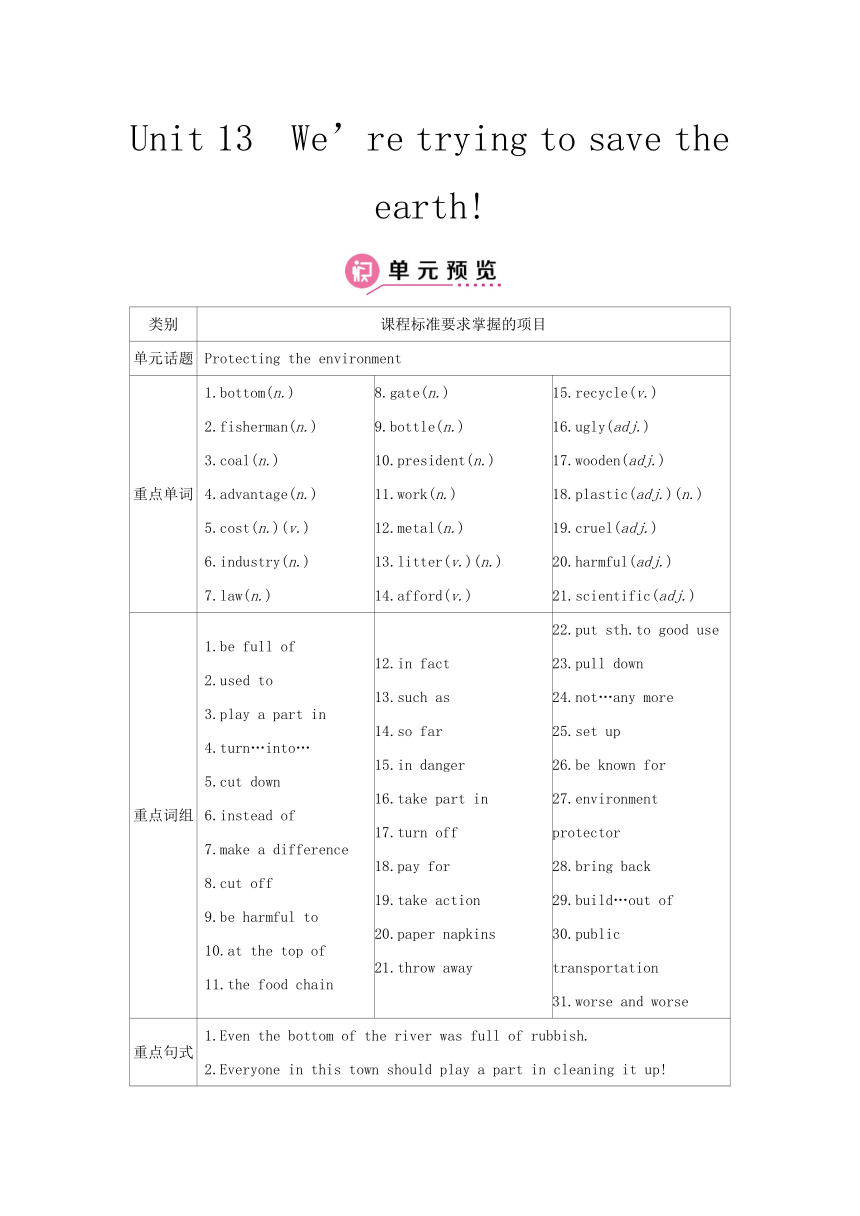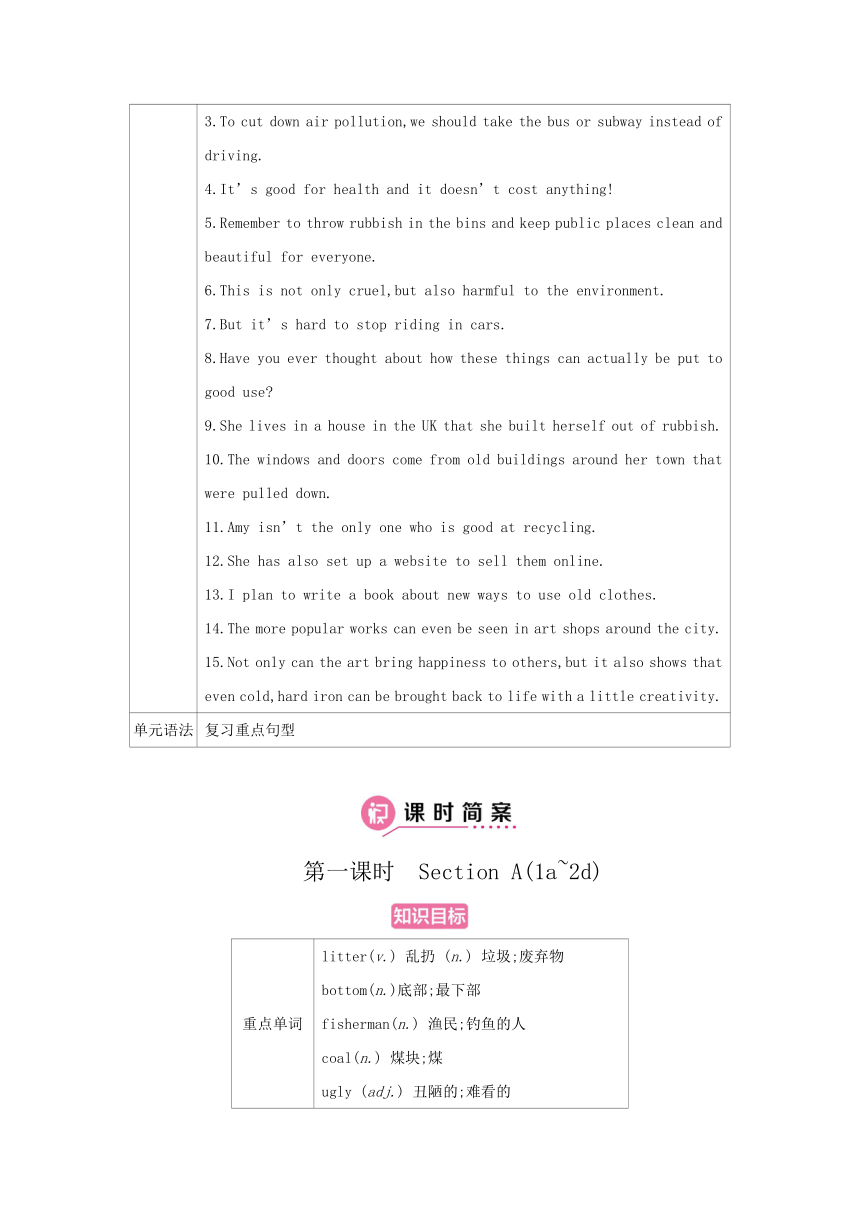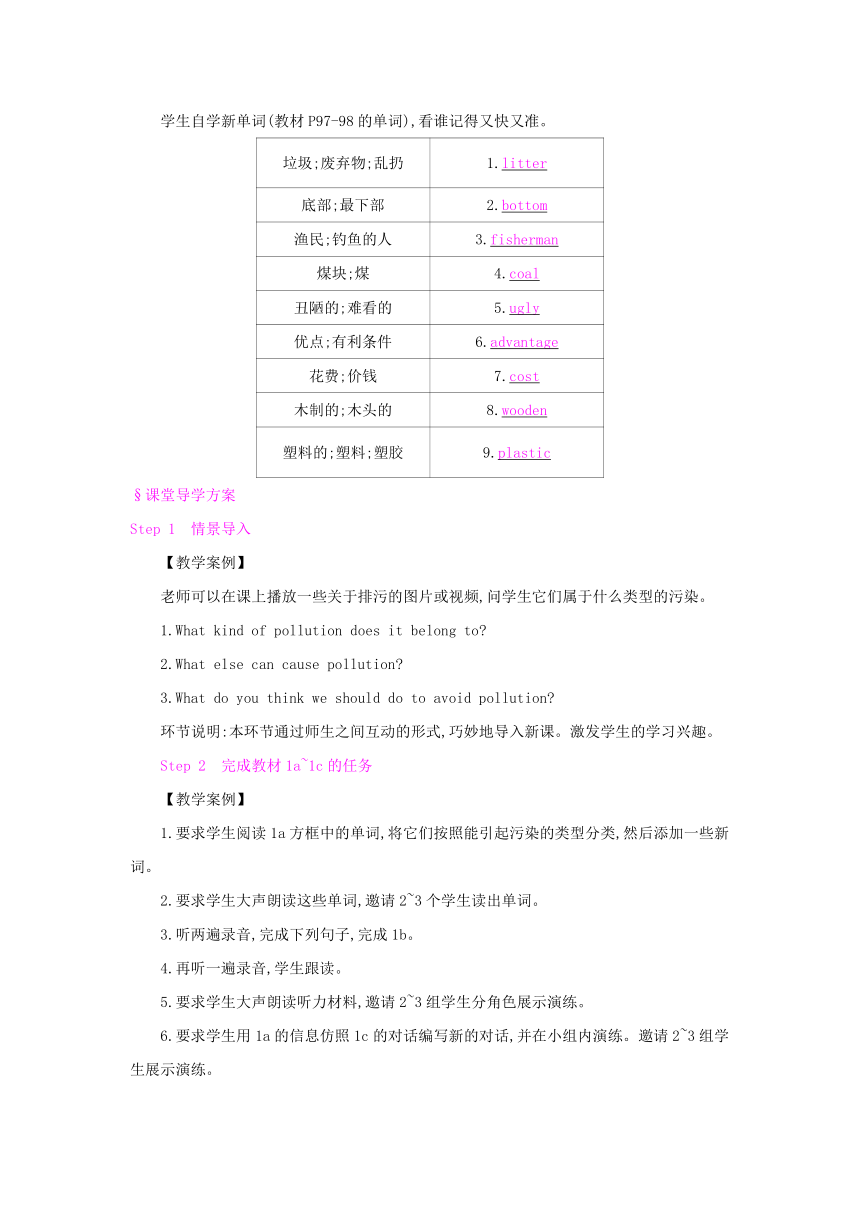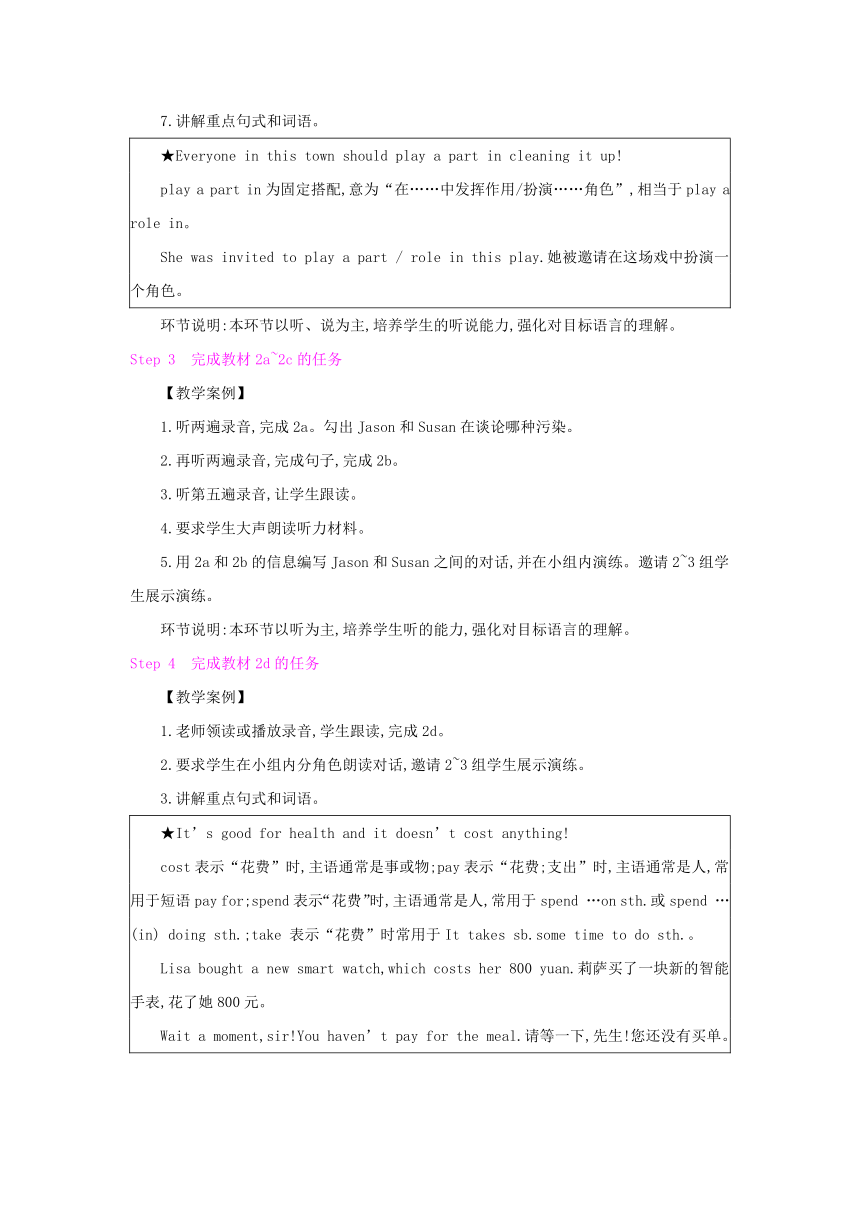Unit 13 We're trying to save the earth 单元教学案(4课时)
文档属性
| 名称 | Unit 13 We're trying to save the earth 单元教学案(4课时) |  | |
| 格式 | docx | ||
| 文件大小 | 77.3KB | ||
| 资源类型 | 教案 | ||
| 版本资源 | 人教新目标(Go for it)版 | ||
| 科目 | 英语 | ||
| 更新时间 | 2021-09-11 14:16:52 | ||
图片预览





文档简介
Unit
13
We’re
trying
to
save
the
earth!
类别
课程标准要求掌握的项目
单元话题
Protecting
the
environment
重点单词
1.bottom(n.)
2.fisherman(n.)
3.coal(n.)
4.advantage(n.)
5.cost(n.)(v.)
6.industry(n.)
7.law(n.)
8.gate(n.)
9.bottle(n.)
10.president(n.)
11.work(n.)
12.metal(n.)
13.litter(v.)(n.)
14.afford(v.)
15.recycle(v.)
16.ugly(adj.)
17.wooden(adj.)
18.plastic(adj.)(n.)
19.cruel(adj.)
20.harmful(adj.)
21.scientific(adj.)
重点词组
1.be
full
of
2.used
to
3.play
a
part
in
4.turn…into…
5.cut
down
6.instead
of
7.make
a
difference
8.cut
off
9.be
harmful
to
10.at
the
top
of
11.the
food
chain
12.in
fact
13.such
as
14.so
far
15.in
danger
16.take
part
in
17.turn
off
18.pay
for
19.take
action
20.paper
napkins
21.throw
away
22.put
sth.to
good
use
23.pull
down
24.not…any
more
25.set
up
26.be
known
for
27.environment
protector
28.bring
back
29.build…out
of
30.public
transportation
31.worse
and
worse
重点句式
1.Even
the
bottom
of
the
river
was
full
of
rubbish.
2.Everyone
in
this
town
should
play
a
part
in
cleaning
it
up!
3.To
cut
down
air
pollution,we
should
take
the
bus
or
subway
instead
of
driving.
4.It’s
good
for
health
and
it
doesn’t
cost
anything!
5.Remember
to
throw
rubbish
in
the
bins
and
keep
public
places
clean
and
beautiful
for
everyone.
6.This
is
not
only
cruel,but
also
harmful
to
the
environment.
7.But
it’s
hard
to
stop
riding
in
cars.
8.Have
you
ever
thought
about
how
these
things
can
actually
be
put
to
good
use?
9.She
lives
in
a
house
in
the
UK
that
she
built
herself
out
of
rubbish.
10.The
windows
and
doors
come
from
old
buildings
around
her
town
that
were
pulled
down.
11.Amy
isn’t
the
only
one
who
is
good
at
recycling.
12.She
has
also
set
up
a
website
to
sell
them
online.
13.I
plan
to
write
a
book
about
new
ways
to
use
old
clothes.
14.The
more
popular
works
can
even
be
seen
in
art
shops
around
the
city.
15.Not
only
can
the
art
bring
happiness
to
others,but
it
also
shows
that
even
cold,hard
iron
can
be
brought
back
to
life
with
a
little
creativity.
单元语法
复习重点句型
第一课时 Section
A(1a~2d)
重点单词
litter(v.)
乱扔
(n.)
垃圾;废弃物
bottom(n.)底部;最下部
fisherman(n.)
渔民;钓鱼的人
coal(n.)
煤块;煤
ugly
(adj.)
丑陋的;难看的
advantage(n.)
优点;有利条件
cost(v.)
花费;(n.)花费;价钱
wooden(adj.)
木制的;木头的
plastic(adj.)
塑料的;(n.)
塑料;塑胶
重点词组
be
full
of装满了……
used
to过去常常
play
a
part
in在……中发挥作用
turn…into…把……变成……
cut
down砍伐;消减
instead
of而不是
make
a
difference对……有影响
重点句式
Even
the
bottom
of
the
river
was
full
of
rubbish.甚至河流的底部都充满了垃圾。
Everyone
in
this
town
should
play
a
part
in
cleaning
it
up!这个镇上的每个人都应当在清理它的过程中发挥作用!
To
cut
down
air
pollution,we
should
take
the
bus
or
subway
instead
of
driving.为了减少空气污染,我们应当乘坐公交车或地铁而不是开车。
It’s
good
for
health
and
it
doesn’t
cost
anything!它对健康是有好处的,而且不花任何钱!
Remember
to
throw
rubbish
in
the
bins
and
keep
public
places
clean
and
beautiful
for
everyone.记住把垃圾投进垃圾箱,为了大家保持公共场所清洁和美丽。
§自主学习方案
学生自学新单词(教材P97-98的单词),看谁记得又快又准。
垃圾;废弃物;乱扔
1.litter
底部;最下部
2.bottom
渔民;钓鱼的人
3.fisherman
煤块;煤
4.coal
丑陋的;难看的
5.ugly
优点;有利条件
6.advantage
花费;价钱
7.cost
木制的;木头的
8.wooden
塑料的;塑料;塑胶
9.plastic
§课堂导学方案
Step
1 情景导入
【教学案例】
老师可以在课上播放一些关于排污的图片或视频,问学生它们属于什么类型的污染。
1.What
kind
of
pollution
does
it
belong
to?
2.What
else
can
cause
pollution?
3.What
do
you
think
we
should
do
to
avoid
pollution?
环节说明:本环节通过师生之间互动的形式,巧妙地导入新课。激发学生的学习兴趣。
Step
2 完成教材1a~1c的任务
【教学案例】
1.要求学生阅读1a方框中的单词,将它们按照能引起污染的类型分类,然后添加一些新词。
2.要求学生大声朗读这些单词,邀请2~3个学生读出单词。
3.听两遍录音,完成下列句子,完成1b。
4.再听一遍录音,学生跟读。
5.要求学生大声朗读听力材料,邀请2~3组学生分角色展示演练。
6.要求学生用1a的信息仿照1c的对话编写新的对话,并在小组内演练。邀请2~3组学生展示演练。
7.讲解重点句式和词语。
★Everyone
in
this
town
should
play
a
part
in
cleaning
it
up!
play
a
part
in为固定搭配,意为“在……中发挥作用/扮演……角色”,相当于play
a
role
in。
She
was
invited
to
play
a
part
/
role
in
this
play.她被邀请在这场戏中扮演一个角色。
环节说明:本环节以听、说为主,培养学生的听说能力,强化对目标语言的理解。
Step
3 完成教材2a~2c的任务
【教学案例】
1.听两遍录音,完成2a。勾出Jason和Susan在谈论哪种污染。
2.再听两遍录音,完成句子,完成2b。
3.听第五遍录音,让学生跟读。
4.要求学生大声朗读听力材料。
5.用2a和2b的信息编写Jason和Susan之间的对话,并在小组内演练。邀请2~3组学生展示演练。
环节说明:本环节以听为主,培养学生听的能力,强化对目标语言的理解。
Step
4 完成教材2d的任务
【教学案例】
1.老师领读或播放录音,学生跟读,完成2d。
2.要求学生在小组内分角色朗读对话,邀请2~3组学生展示演练。
3.讲解重点句式和词语。
★It’s
good
for
health
and
it
doesn’t
cost
anything!
cost表示“花费”时,主语通常是事或物;pay表示“花费;支出”时,主语通常是人,常用于短语pay
for;spend表示“花费”时,主语通常是人,常用于spend
…on
sth.或spend
…(in)
doing
sth.;take
表示“花费”时常用于It
takes
sb.some
time
to
do
sth.。
Lisa
bought
a
new
smart
watch,which
costs
her
800
yuan.莉萨买了一块新的智能手表,花了她800元。
Wait
a
moment,sir!You
haven’t
pay
for
the
meal.请等一下,先生!您还没有买单。
I
spent
two
hours
working
out
the
math
problem
yesterday.昨天我花了两个小时算出这道数学题。
It
took
me
an
hour
to
get
home
from
work
this
afternoon.今天下午从工作单位到家花了我一个小时的时间。
4.小结训练。
根据汉语提示完成下列句子,每空一词。
(1)Eggs play
an
important
role
in
the
activity.(在……中扮演……角色)?
(2)The
boy
is
always full
of
life
and
energy.(充满)?
(3)If
people
keep
on cutting
down
trees,animals
will
have
no
place
to
live
in.(砍伐)?
(4)Do
you
think
his
words
will make
a
difference
to
the
final
decision?(产生影响)?
(5)Mr.Smith
always
says
that
hard
work
and
good
methods lead
us
to
success.(导致)?
环节说明:本环节以讲练结合的方式来强化对目标语言的理解和运用。
第二课时 Section
A(3a~4c)
重点单词
cruel(adj.)
残酷的;残忍的
harmful(adj.)
有害的
industry(n.)
工业;行业
law(n.)
法律;法规
scientific(adj.)
科学上的;科学的
afford(v.)
承担得起(后果);买得起
重点词组
cut
off割掉
be
harmful
to对……有害
at
the
top
of在……顶部
the
food
chain食物链
in
fact事实上
such
as例如
so
far到目前为止
in
danger处于危险中
take
part
in参加
turn
off关掉
pay
for支付
take
action采取行动
重点句式
This
is
not
only
cruel,but
also
harmful
to
the
environment.这不仅是残忍的,而且对环境有害。
They
have
even
asked
governments
to
develop
laws
to
stop
the
sale
of
shark
fins.他们甚至要求政府制定法律来阻止鲨鱼鱼翅的买卖。
§自主学习方案
学生自学新单词(教材P99-100的单词),看谁记得又快又准。
残酷的;残忍的
1.cruel
有害的
2.harmful
工业;行业
3.industry
法律
4.law
科学上的;科学的
5.scientific
承担得起(后果);买得起
6.afford
§课堂导学方案
Step
1 情景导入
【教学案例】
课上老师可以播放有关鲨鱼和禁止捕杀动物的图片或视频,让学生明白保护动物的重要性。可以设置几个问题。
1.Have
you
eaten
shark
fins?
2.What
do
you
think
of
the
sale
about
the
animals?
3.What
do
you
think
we
should
do
to
protect
the
animals?
环节说明:本环节通过播放关于鲨鱼和捕杀动物的图片或视频的方式,让学生知道保护动物刻不容缓。
Step
2 完成教材3a~3b的任务
【教学案例】
1.要求学生默读课文,完成3a中的表格。邀请2~3个学生给出他们的答案。
2.老师领读或播放录音,学生跟读。
3.要求学生大声朗读课文,邀请2~3个学生分段落朗读课文。
4.再次要求学生默读课文,用方框中的单词填空,完成3b。邀请1~2个学生读出他们的答案。
5.要求学生大声朗读3b中的句子。
环节说明:本环节以自学为主,培养学生读的能力,强化对目标语言的理解和运用。
Step
3 完成教材Grammar
Focus~4c的任务
【教学案例】
1.要求学生将Grammar
Focus表格中的句子译成汉语,邀请1~2个学生给出汉语意思。
2.要求学生说出Grammar
Focus所复习的语法内容,邀请1~2个学生给出答案。
3.用括号内单词的正确形式填空,完成4a。邀请1~2个学生给出答案。
4.要求学生大声朗读4a的句子。
5.要求学生从方框中选择情态动词完成短文。
6.列出你能做的事来保护环境,然后在小组内讨论你所列举出来的例子。
环节说明:本环节以练为主,巩固对目标语言的运用和理解。
第三课时 Section
B(1a~1e)
重点单词
recycle
(v.)回收利用;再利用
重点词组
paper
napkins纸巾
throw
away扔掉
重点句式
But
it’s
hard
to
stop
riding
in
cars.但是停止开车出行是困难的。
§自主学习方案
学生自学新单词(教材P101的单词),看谁记得又快又准。
回收利用;再利用
1.recycle
餐巾;餐巾纸
2.napkin
§课堂导学方案
Step
1 情景导入
【教学案例】
在课堂上播放一些有关环保行动的图片或视频,然后在小组内讨论怎样做才是环保行动。
环节说明:本环节以讨论为主,引出环保行动的话题。
Step
2 完成教材1a~1d的任务
【教学案例】
1.要求学生大声朗读1a的句子,然后给这些行动排序,从最容易到最难。邀请1~2个学生给出答案。
2.要求学生用1a的信息,仿照1b的对话编写自己的对话,并在小组内演练。邀请2~3组学生展示演练。
3.听两遍录音,勾出Julia和Jack谈论的事情。完成1c。
4.再听两遍录音,勾出Julia正在做的事,将要做的事和不会做的事。
5.听第五遍录音,学生跟读。
6.要求学生大声朗读听力材料。
环节说明:本环节以听为主,培养学生听的能力,准确理解目标语言。
Step
3 完成教材1e的任务
【教学案例】
1.要求学生用1c表格中的信息编写对话,在小组内演练。邀请2~3组学生展示演练。
2.小结训练。
根据句意,用括号内所给单词的适当形式填空。
(1)Have
you
ever
collected
waste
paper
or
bottles
for
recycling ?(recycle)?
(2)People
shouldn’t
use
paper
napkins
to
protect
the
environment.(napkin)?
(3)We
all took
part
in
the
school
trip
last
week.(take)
?
(4)His
father used
to
drive
to
work
but
now
he
walks
to
work.(use)?
(5)It
is
hard
to
stop
riding
in
cars
and
start
riding
bikes.(ride)?
环节说明:本环节以说为主,在说的过程中正确使用目标语言。
第四课时 Section
B(2a~Self
Check)
重点单词
gate
(n.)大门
bottle(n.)瓶子
president
(n.)负责人;主席;总统
work
(n.)(音乐、艺术)
作品
metal(n.)金属
重点词组
put
sth.to
good
use好好利用某物
pull
down拆下;摧毁
not
…any
more不再
set
up建立
be
known
for以……而著名
environment
protector环境保护者
重点词组
bring
back恢复;使想起;归还
build
…out
of用……制成
public
transportation公共交通
worse
and
worse
越来越差
重点句式
Have
you
ever
thought
about
how
these
things
can
actually
be
put
to
good
use?你曾经考虑过这些东西怎样被实际上好好地利用吗?
She
lives
in
a
house
in
the
UK
that
she
built
herself
out
of
rubbish.她住在英国的一所房子里,这所房屋是她用垃圾建造的。
The
windows
and
doors
come
from
old
buildings
around
her
town
that
were
pulled
down.窗户和门来自镇上被拆掉的旧楼房。
Amy
isn’t
the
only
one
who
is
good
at
recycling.艾米不是唯一一个善于再利用的人。
She
has
also
set
up
a
website
to
sell
them
online.她也开办了一个网站在网上销售它们。
I
plan
to
write
a
book
about
new
ways
to
use
old
clothes.我计划写一本关于利用旧衣服的新方法。
The
more
popular
works
can
even
be
seen
in
art
shops
around
the
city.更加流行的艺术品甚至能在全市的艺术品店被看到。
Not
only
can
the
art
bring
happiness
to
others,but
it
also
shows
that
even
cold,hard
iron
can
be
brought
back
to
life
with
a
little
creativity.这些艺术品不仅能给别人带来幸福,而且也显示了用一点创意,甚至冰冷的、坚硬的钢铁也能被赋予生命。
§自主学习方案
学生自学新单词(教材P102-104的单词),看谁记得又快又准。
大门
1.gate
瓶子
2.bottle
负责人;主席;总统
3.president
(音乐、艺术)
作品
4.work
金属
5.metal
§课堂导学方案
Step
1 情景导入
【教学案例】
播放一些用垃圾制作的精美物件的视频,让学生展开想象,说说这些物件是用什么制作的。让学生们讨论还能用垃圾制作什么物品。
环节说明:本环节用精美的垃圾制成的物品来吸引学生讨论垃圾的充分利用的话题让课堂更加生动。
Step
2 完成教材2a~2e的任务
【教学案例】
1.要求学生观看2b的图片,猜测2b的短文是关于什么的。
完成2a。邀请1~2个学生给出他们的观点。
2.要求学生默读课文,完成2b下面的表格。完成2b。
3.老师领读或播放录音,学生跟读课文。
4.要求学生用2c方框中的短语的正确形式填空,完成2c。邀请1~2个学生给出他们的答案。
5.细读课文,在文中找出由2d方框中所给单词变化而来的单词,并标明下划线,比较它们的不同。
6.要求学生列出需要做什么事来拯救环境。在小组内讨论,哪些事由普通人来做,哪些事由政府或组织来做。
7.讲解重点句式和词语。
★Have
you
ever
thought
about
how
these
things
can
actually
be
put
to
good
use?
put
sth.to
good
use意为“好好利用某物”,其中use为名词。be
put
to
good
use为其被动结构。
Children
should
learn
to
put
their
pocket
money
to
good
use.孩子们应该学会好好利用零花钱。
★…,but
she
is
a
most
unusual
woman.
a
+most
+adj.+n.是一个固定结构,意为“一个很/
非常……的……”,此处most不表示最高级含义。
This
is
a
most
useful
tool.这是一个非常有用的工具。
环节说明:本环节以自学为主,强化对目标语言的理解和运用。
Step
3 完成教材3a~3b的任务
【教学案例】
1.在小组内讨论一下我们城镇的环境。哪些地方是好的?哪些地方是需要改善的?为什么?并做出笔记。完成3a。
2.按照3b的提示思路,给市长写一封信反应一下我们城市的环境问题,并给出你的建议。完成3b。
环节说明:本环节以写为主,强化对目标语言的运用和理解,在写的过程中记忆目标语言。
Step
4 完成Self
Check的任务
【教学案例】
1.按要求写出每个单词的不同形式,可以再增加其他单词。完成1题。
2.将下列描述与所包含的语法点连线。完成2题。
3.在小组内讨论消减这些污染的方法,并写出来。完成3题。
4.小结训练。
根据汉语提示完成句子,每空一词。
(1)Don’t
throw
away
those
old
clothes.Please
put
them
in
the
recycling
bin.(扔掉)?
(2)Your
creative
ideas
should
be put
to
good
use .(好好利用)?
(3)If
you
turn
the
paper
bag upside
down ,the
key
will
fall
out
of
it.(倒过来)?
(4)To
build
the
road,people
decided
to
pull
down the
old
city
wall.(拆掉)?
(5)A
great
doctor
can
usually bring
dying
patient
back
to
life .(使……起死回生)?
环节说明:本环节以练为主,强化对语法内容的理解和运用。
13
We’re
trying
to
save
the
earth!
类别
课程标准要求掌握的项目
单元话题
Protecting
the
environment
重点单词
1.bottom(n.)
2.fisherman(n.)
3.coal(n.)
4.advantage(n.)
5.cost(n.)(v.)
6.industry(n.)
7.law(n.)
8.gate(n.)
9.bottle(n.)
10.president(n.)
11.work(n.)
12.metal(n.)
13.litter(v.)(n.)
14.afford(v.)
15.recycle(v.)
16.ugly(adj.)
17.wooden(adj.)
18.plastic(adj.)(n.)
19.cruel(adj.)
20.harmful(adj.)
21.scientific(adj.)
重点词组
1.be
full
of
2.used
to
3.play
a
part
in
4.turn…into…
5.cut
down
6.instead
of
7.make
a
difference
8.cut
off
9.be
harmful
to
10.at
the
top
of
11.the
food
chain
12.in
fact
13.such
as
14.so
far
15.in
danger
16.take
part
in
17.turn
off
18.pay
for
19.take
action
20.paper
napkins
21.throw
away
22.put
sth.to
good
use
23.pull
down
24.not…any
more
25.set
up
26.be
known
for
27.environment
protector
28.bring
back
29.build…out
of
30.public
transportation
31.worse
and
worse
重点句式
1.Even
the
bottom
of
the
river
was
full
of
rubbish.
2.Everyone
in
this
town
should
play
a
part
in
cleaning
it
up!
3.To
cut
down
air
pollution,we
should
take
the
bus
or
subway
instead
of
driving.
4.It’s
good
for
health
and
it
doesn’t
cost
anything!
5.Remember
to
throw
rubbish
in
the
bins
and
keep
public
places
clean
and
beautiful
for
everyone.
6.This
is
not
only
cruel,but
also
harmful
to
the
environment.
7.But
it’s
hard
to
stop
riding
in
cars.
8.Have
you
ever
thought
about
how
these
things
can
actually
be
put
to
good
use?
9.She
lives
in
a
house
in
the
UK
that
she
built
herself
out
of
rubbish.
10.The
windows
and
doors
come
from
old
buildings
around
her
town
that
were
pulled
down.
11.Amy
isn’t
the
only
one
who
is
good
at
recycling.
12.She
has
also
set
up
a
website
to
sell
them
online.
13.I
plan
to
write
a
book
about
new
ways
to
use
old
clothes.
14.The
more
popular
works
can
even
be
seen
in
art
shops
around
the
city.
15.Not
only
can
the
art
bring
happiness
to
others,but
it
also
shows
that
even
cold,hard
iron
can
be
brought
back
to
life
with
a
little
creativity.
单元语法
复习重点句型
第一课时 Section
A(1a~2d)
重点单词
litter(v.)
乱扔
(n.)
垃圾;废弃物
bottom(n.)底部;最下部
fisherman(n.)
渔民;钓鱼的人
coal(n.)
煤块;煤
ugly
(adj.)
丑陋的;难看的
advantage(n.)
优点;有利条件
cost(v.)
花费;(n.)花费;价钱
wooden(adj.)
木制的;木头的
plastic(adj.)
塑料的;(n.)
塑料;塑胶
重点词组
be
full
of装满了……
used
to过去常常
play
a
part
in在……中发挥作用
turn…into…把……变成……
cut
down砍伐;消减
instead
of而不是
make
a
difference对……有影响
重点句式
Even
the
bottom
of
the
river
was
full
of
rubbish.甚至河流的底部都充满了垃圾。
Everyone
in
this
town
should
play
a
part
in
cleaning
it
up!这个镇上的每个人都应当在清理它的过程中发挥作用!
To
cut
down
air
pollution,we
should
take
the
bus
or
subway
instead
of
driving.为了减少空气污染,我们应当乘坐公交车或地铁而不是开车。
It’s
good
for
health
and
it
doesn’t
cost
anything!它对健康是有好处的,而且不花任何钱!
Remember
to
throw
rubbish
in
the
bins
and
keep
public
places
clean
and
beautiful
for
everyone.记住把垃圾投进垃圾箱,为了大家保持公共场所清洁和美丽。
§自主学习方案
学生自学新单词(教材P97-98的单词),看谁记得又快又准。
垃圾;废弃物;乱扔
1.litter
底部;最下部
2.bottom
渔民;钓鱼的人
3.fisherman
煤块;煤
4.coal
丑陋的;难看的
5.ugly
优点;有利条件
6.advantage
花费;价钱
7.cost
木制的;木头的
8.wooden
塑料的;塑料;塑胶
9.plastic
§课堂导学方案
Step
1 情景导入
【教学案例】
老师可以在课上播放一些关于排污的图片或视频,问学生它们属于什么类型的污染。
1.What
kind
of
pollution
does
it
belong
to?
2.What
else
can
cause
pollution?
3.What
do
you
think
we
should
do
to
avoid
pollution?
环节说明:本环节通过师生之间互动的形式,巧妙地导入新课。激发学生的学习兴趣。
Step
2 完成教材1a~1c的任务
【教学案例】
1.要求学生阅读1a方框中的单词,将它们按照能引起污染的类型分类,然后添加一些新词。
2.要求学生大声朗读这些单词,邀请2~3个学生读出单词。
3.听两遍录音,完成下列句子,完成1b。
4.再听一遍录音,学生跟读。
5.要求学生大声朗读听力材料,邀请2~3组学生分角色展示演练。
6.要求学生用1a的信息仿照1c的对话编写新的对话,并在小组内演练。邀请2~3组学生展示演练。
7.讲解重点句式和词语。
★Everyone
in
this
town
should
play
a
part
in
cleaning
it
up!
play
a
part
in为固定搭配,意为“在……中发挥作用/扮演……角色”,相当于play
a
role
in。
She
was
invited
to
play
a
part
/
role
in
this
play.她被邀请在这场戏中扮演一个角色。
环节说明:本环节以听、说为主,培养学生的听说能力,强化对目标语言的理解。
Step
3 完成教材2a~2c的任务
【教学案例】
1.听两遍录音,完成2a。勾出Jason和Susan在谈论哪种污染。
2.再听两遍录音,完成句子,完成2b。
3.听第五遍录音,让学生跟读。
4.要求学生大声朗读听力材料。
5.用2a和2b的信息编写Jason和Susan之间的对话,并在小组内演练。邀请2~3组学生展示演练。
环节说明:本环节以听为主,培养学生听的能力,强化对目标语言的理解。
Step
4 完成教材2d的任务
【教学案例】
1.老师领读或播放录音,学生跟读,完成2d。
2.要求学生在小组内分角色朗读对话,邀请2~3组学生展示演练。
3.讲解重点句式和词语。
★It’s
good
for
health
and
it
doesn’t
cost
anything!
cost表示“花费”时,主语通常是事或物;pay表示“花费;支出”时,主语通常是人,常用于短语pay
for;spend表示“花费”时,主语通常是人,常用于spend
…on
sth.或spend
…(in)
doing
sth.;take
表示“花费”时常用于It
takes
sb.some
time
to
do
sth.。
Lisa
bought
a
new
smart
watch,which
costs
her
800
yuan.莉萨买了一块新的智能手表,花了她800元。
Wait
a
moment,sir!You
haven’t
pay
for
the
meal.请等一下,先生!您还没有买单。
I
spent
two
hours
working
out
the
math
problem
yesterday.昨天我花了两个小时算出这道数学题。
It
took
me
an
hour
to
get
home
from
work
this
afternoon.今天下午从工作单位到家花了我一个小时的时间。
4.小结训练。
根据汉语提示完成下列句子,每空一词。
(1)Eggs play
an
important
role
in
the
activity.(在……中扮演……角色)?
(2)The
boy
is
always full
of
life
and
energy.(充满)?
(3)If
people
keep
on cutting
down
trees,animals
will
have
no
place
to
live
in.(砍伐)?
(4)Do
you
think
his
words
will make
a
difference
to
the
final
decision?(产生影响)?
(5)Mr.Smith
always
says
that
hard
work
and
good
methods lead
us
to
success.(导致)?
环节说明:本环节以讲练结合的方式来强化对目标语言的理解和运用。
第二课时 Section
A(3a~4c)
重点单词
cruel(adj.)
残酷的;残忍的
harmful(adj.)
有害的
industry(n.)
工业;行业
law(n.)
法律;法规
scientific(adj.)
科学上的;科学的
afford(v.)
承担得起(后果);买得起
重点词组
cut
off割掉
be
harmful
to对……有害
at
the
top
of在……顶部
the
food
chain食物链
in
fact事实上
such
as例如
so
far到目前为止
in
danger处于危险中
take
part
in参加
turn
off关掉
pay
for支付
take
action采取行动
重点句式
This
is
not
only
cruel,but
also
harmful
to
the
environment.这不仅是残忍的,而且对环境有害。
They
have
even
asked
governments
to
develop
laws
to
stop
the
sale
of
shark
fins.他们甚至要求政府制定法律来阻止鲨鱼鱼翅的买卖。
§自主学习方案
学生自学新单词(教材P99-100的单词),看谁记得又快又准。
残酷的;残忍的
1.cruel
有害的
2.harmful
工业;行业
3.industry
法律
4.law
科学上的;科学的
5.scientific
承担得起(后果);买得起
6.afford
§课堂导学方案
Step
1 情景导入
【教学案例】
课上老师可以播放有关鲨鱼和禁止捕杀动物的图片或视频,让学生明白保护动物的重要性。可以设置几个问题。
1.Have
you
eaten
shark
fins?
2.What
do
you
think
of
the
sale
about
the
animals?
3.What
do
you
think
we
should
do
to
protect
the
animals?
环节说明:本环节通过播放关于鲨鱼和捕杀动物的图片或视频的方式,让学生知道保护动物刻不容缓。
Step
2 完成教材3a~3b的任务
【教学案例】
1.要求学生默读课文,完成3a中的表格。邀请2~3个学生给出他们的答案。
2.老师领读或播放录音,学生跟读。
3.要求学生大声朗读课文,邀请2~3个学生分段落朗读课文。
4.再次要求学生默读课文,用方框中的单词填空,完成3b。邀请1~2个学生读出他们的答案。
5.要求学生大声朗读3b中的句子。
环节说明:本环节以自学为主,培养学生读的能力,强化对目标语言的理解和运用。
Step
3 完成教材Grammar
Focus~4c的任务
【教学案例】
1.要求学生将Grammar
Focus表格中的句子译成汉语,邀请1~2个学生给出汉语意思。
2.要求学生说出Grammar
Focus所复习的语法内容,邀请1~2个学生给出答案。
3.用括号内单词的正确形式填空,完成4a。邀请1~2个学生给出答案。
4.要求学生大声朗读4a的句子。
5.要求学生从方框中选择情态动词完成短文。
6.列出你能做的事来保护环境,然后在小组内讨论你所列举出来的例子。
环节说明:本环节以练为主,巩固对目标语言的运用和理解。
第三课时 Section
B(1a~1e)
重点单词
recycle
(v.)回收利用;再利用
重点词组
paper
napkins纸巾
throw
away扔掉
重点句式
But
it’s
hard
to
stop
riding
in
cars.但是停止开车出行是困难的。
§自主学习方案
学生自学新单词(教材P101的单词),看谁记得又快又准。
回收利用;再利用
1.recycle
餐巾;餐巾纸
2.napkin
§课堂导学方案
Step
1 情景导入
【教学案例】
在课堂上播放一些有关环保行动的图片或视频,然后在小组内讨论怎样做才是环保行动。
环节说明:本环节以讨论为主,引出环保行动的话题。
Step
2 完成教材1a~1d的任务
【教学案例】
1.要求学生大声朗读1a的句子,然后给这些行动排序,从最容易到最难。邀请1~2个学生给出答案。
2.要求学生用1a的信息,仿照1b的对话编写自己的对话,并在小组内演练。邀请2~3组学生展示演练。
3.听两遍录音,勾出Julia和Jack谈论的事情。完成1c。
4.再听两遍录音,勾出Julia正在做的事,将要做的事和不会做的事。
5.听第五遍录音,学生跟读。
6.要求学生大声朗读听力材料。
环节说明:本环节以听为主,培养学生听的能力,准确理解目标语言。
Step
3 完成教材1e的任务
【教学案例】
1.要求学生用1c表格中的信息编写对话,在小组内演练。邀请2~3组学生展示演练。
2.小结训练。
根据句意,用括号内所给单词的适当形式填空。
(1)Have
you
ever
collected
waste
paper
or
bottles
for
recycling ?(recycle)?
(2)People
shouldn’t
use
paper
napkins
to
protect
the
environment.(napkin)?
(3)We
all took
part
in
the
school
trip
last
week.(take)
?
(4)His
father used
to
drive
to
work
but
now
he
walks
to
work.(use)?
(5)It
is
hard
to
stop
riding
in
cars
and
start
riding
bikes.(ride)?
环节说明:本环节以说为主,在说的过程中正确使用目标语言。
第四课时 Section
B(2a~Self
Check)
重点单词
gate
(n.)大门
bottle(n.)瓶子
president
(n.)负责人;主席;总统
work
(n.)(音乐、艺术)
作品
metal(n.)金属
重点词组
put
sth.to
good
use好好利用某物
pull
down拆下;摧毁
not
…any
more不再
set
up建立
be
known
for以……而著名
environment
protector环境保护者
重点词组
bring
back恢复;使想起;归还
build
…out
of用……制成
public
transportation公共交通
worse
and
worse
越来越差
重点句式
Have
you
ever
thought
about
how
these
things
can
actually
be
put
to
good
use?你曾经考虑过这些东西怎样被实际上好好地利用吗?
She
lives
in
a
house
in
the
UK
that
she
built
herself
out
of
rubbish.她住在英国的一所房子里,这所房屋是她用垃圾建造的。
The
windows
and
doors
come
from
old
buildings
around
her
town
that
were
pulled
down.窗户和门来自镇上被拆掉的旧楼房。
Amy
isn’t
the
only
one
who
is
good
at
recycling.艾米不是唯一一个善于再利用的人。
She
has
also
set
up
a
website
to
sell
them
online.她也开办了一个网站在网上销售它们。
I
plan
to
write
a
book
about
new
ways
to
use
old
clothes.我计划写一本关于利用旧衣服的新方法。
The
more
popular
works
can
even
be
seen
in
art
shops
around
the
city.更加流行的艺术品甚至能在全市的艺术品店被看到。
Not
only
can
the
art
bring
happiness
to
others,but
it
also
shows
that
even
cold,hard
iron
can
be
brought
back
to
life
with
a
little
creativity.这些艺术品不仅能给别人带来幸福,而且也显示了用一点创意,甚至冰冷的、坚硬的钢铁也能被赋予生命。
§自主学习方案
学生自学新单词(教材P102-104的单词),看谁记得又快又准。
大门
1.gate
瓶子
2.bottle
负责人;主席;总统
3.president
(音乐、艺术)
作品
4.work
金属
5.metal
§课堂导学方案
Step
1 情景导入
【教学案例】
播放一些用垃圾制作的精美物件的视频,让学生展开想象,说说这些物件是用什么制作的。让学生们讨论还能用垃圾制作什么物品。
环节说明:本环节用精美的垃圾制成的物品来吸引学生讨论垃圾的充分利用的话题让课堂更加生动。
Step
2 完成教材2a~2e的任务
【教学案例】
1.要求学生观看2b的图片,猜测2b的短文是关于什么的。
完成2a。邀请1~2个学生给出他们的观点。
2.要求学生默读课文,完成2b下面的表格。完成2b。
3.老师领读或播放录音,学生跟读课文。
4.要求学生用2c方框中的短语的正确形式填空,完成2c。邀请1~2个学生给出他们的答案。
5.细读课文,在文中找出由2d方框中所给单词变化而来的单词,并标明下划线,比较它们的不同。
6.要求学生列出需要做什么事来拯救环境。在小组内讨论,哪些事由普通人来做,哪些事由政府或组织来做。
7.讲解重点句式和词语。
★Have
you
ever
thought
about
how
these
things
can
actually
be
put
to
good
use?
put
sth.to
good
use意为“好好利用某物”,其中use为名词。be
put
to
good
use为其被动结构。
Children
should
learn
to
put
their
money
to
good
use.孩子们应该学会好好利用零花钱。
★…,but
she
is
a
most
unusual
woman.
a
+most
+adj.+n.是一个固定结构,意为“一个很/
非常……的……”,此处most不表示最高级含义。
This
is
a
most
useful
tool.这是一个非常有用的工具。
环节说明:本环节以自学为主,强化对目标语言的理解和运用。
Step
3 完成教材3a~3b的任务
【教学案例】
1.在小组内讨论一下我们城镇的环境。哪些地方是好的?哪些地方是需要改善的?为什么?并做出笔记。完成3a。
2.按照3b的提示思路,给市长写一封信反应一下我们城市的环境问题,并给出你的建议。完成3b。
环节说明:本环节以写为主,强化对目标语言的运用和理解,在写的过程中记忆目标语言。
Step
4 完成Self
Check的任务
【教学案例】
1.按要求写出每个单词的不同形式,可以再增加其他单词。完成1题。
2.将下列描述与所包含的语法点连线。完成2题。
3.在小组内讨论消减这些污染的方法,并写出来。完成3题。
4.小结训练。
根据汉语提示完成句子,每空一词。
(1)Don’t
throw
away
those
old
clothes.Please
put
them
in
the
recycling
bin.(扔掉)?
(2)Your
creative
ideas
should
be put
to
good
use .(好好利用)?
(3)If
you
turn
the
paper
bag upside
down ,the
key
will
fall
out
of
it.(倒过来)?
(4)To
build
the
road,people
decided
to
pull
down the
old
city
wall.(拆掉)?
(5)A
great
doctor
can
usually bring
dying
patient
back
to
life .(使……起死回生)?
环节说明:本环节以练为主,强化对语法内容的理解和运用。
同课章节目录
- Unit 1 How can we become good learners.
- Section A
- Section B
- Unit 2 I think that mooncakes are delicious!
- Section A
- Section B
- Unit 3 Could you please tell me where the restroom
- Section A
- Section B
- Unit 4 I used to be afraid of the dark.
- Section A
- Section B
- Unit 5 What are the shirts made of?
- Section A
- Section B
- Review of Units 1-5
- Unit 6 When was it invented?
- Section A
- Section B
- Unit 7 Teenagers should be allowed to choose their
- Section A
- Section B
- Unit 8 It must belong to Carla.
- Section A
- Section B
- Unit 9 I like music that I can dance to.
- Section A
- Section B
- Unit 10 You're supposed to shake hands.
- Section A
- Section B
- Review of Units 6-10
- Unit 11 Sad movies make me cry.
- Section A
- Section B
- Unit 12 Life is full of the unexpected
- Section A
- Section B
- Unit 13 We're trying to save the earth!
- Section A
- Section B
- Unit 14 I remember meeting all of you in Grade 7.
- Section A
- Section B
- Review of Units 11-14
